|
|
|
|
|
|
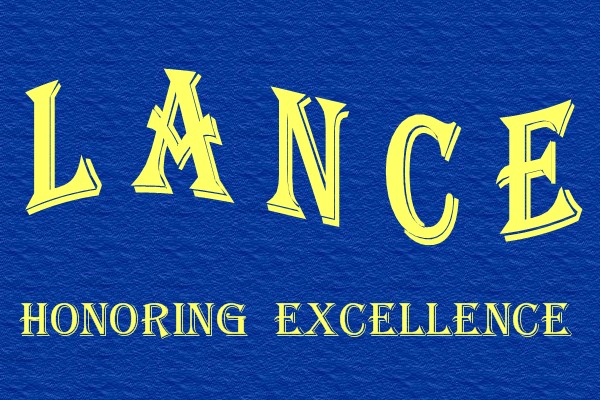 
A star he is ~ but it could have been different. Lance Armstrong could have well been an abortion statistic. His mother was a 16 year old unwed mom and poor. But she did the right thing and was a continual source of support and inspiration to Lance throughout his life. Linda, then a supermarket checkout girl, had got pregnant at the age of 16 and gave birth to her son when she was only 17.
The pair enjoy an exceptionally close relationship, which Linda puts down to the fact that "we grew up together".
Armstrong took on the surname of his stepfather, whom Linda, who has been married and divorced four times, has since separated from the last.
His mother took on a host of jobs to help pay for her son's upbringing - Armstrong has since said he "never wanted for anything" and credits his mother for the work ethic which enabled him to win the Tour de France.
Armstrong's competitive urges were ably backed by Linda, who took him to triathlon events where he made his name as an athlete before getting involved in the US Olympic cycling development program as a teenager.
Okay, bicycling receives many snide looks & remarks from those “who don’t understand”. Athletes who have done a variety of activities competitively, state this is the most grueling activity - bar none. The money is relatively low & the hazards high & the training nothing less than brutal. This is not for wimps. Most are not the stars like lance with a future secure but their love of the activity & competitive sport keep them coming back.
Let’s take a few seconds to mention three of the “troubling” issues by Lance distracters -
1) He has NEVER tested positive for any enhancing/illegal drugs, although he is the MOST tested cyclist that has ever ridden.
2) He met Cheryl Crow a month AFTER his divorce papers were filed with Kristin who was unwilling to support his bicycling career any longer.
3) He remains good friends with LONGTIME friend George Bush despite the concerns over the war & funding which he wishes could be used for cancer research.
Lance Armstrong (born September 18, 1971 in Plano, Texas) is a newly retired American professional road racing cyclist. He is most famous for recovering from testicular/brain/lung cancer to subsequently win the Tour de France a record seven consecutive times—1999 to 2005. His success prompted some to nickname the event the Tour de Lance.
Armstrong's achievements have been widely lauded. A few..In 2002, Sports Illustrated magazine named him their Sportsman of the Year. He was also named Associated Press Male Athlete of the Year for 2002, 2003 and 2004, received ESPN's ESPY Award for Best Male Athlete in 2003, 2004, and 2005, and won the BBC Sports Personality of the Year Overseas Personality Award in 2003. Armstrong retired from racing at the end of the 2005 Tour de France.
The Awful “C” word
On October 2, 1996, Armstrong was diagnosed with testicular cancer that had metastasized, spreading to his lungs and brain. His doctors told him that he had a 40 percent chance of survival. After his recovery, one of his doctors told him that his actual odds of survival had been considerably smaller (one even went as far as to say three percent), and that he had been given the estimate primarily to give him hope. The date of October 2 was eventually commemorated by Armstrong and Nike, through the "10 / 2" line of merchandise, of which part of the proceeds would go to the Lance Armstrong Foundation, which was founded in 1997.
Armstrong managed to recover after invasive surgery to remove his right testicle and two brain lesions, and a severe course of chemotherapy, performed at Indiana University School of Medicine, which left him with burns on the inside of his skin. The standard chemotherapy for his cancer would have meant the end of his cycling career, because a known side effect was a dramatic reduction in lung function; he opted for a more severe treatment that was less likely to result in lung damage.
While in remission he resumed training, but his contract had been canceled by his Cofidis team. This was one of the factors which led to his near retirement from the sport, because of which he and his then-girlfriend (now ex-wife) moved to France on two different occasions due to his changes of heart. Lance and his “ex” the former Kristin "Kik" (pronounced Keek) Richard, had a son, Luke, shortly after his amazing comeback victory, and twin girls Grace and Isabelle two years later, all by in vitro fertilization. They divorced in 2003 and he later entered into a relationship with singer Sheryl Crow, who supported his cycling, following the 2004 and 2005 tours by car.
 Armstrong has diversified interests outside cycling. He had a cameo role in the film Dodgeball: A True Underdog Story and has topped the bestsellers' lists with his book It's Not About the Bike. He has also become a spokesperson for the cancer research movement.
He was eventually signed by the newly formed United States Postal Service Pro Cycling Team, and by 1998, he was able to make his successful return in the cycling world marked by his fourth place overall finish in the Vuelta a España.
Livestrong and the Lance Armstrong Foundation
During summer 2004, the Lance Armstrong Foundation (with initial funding from Nike), developed the Livestrong wristband. The band was part of the Wear Yellow Live Strong educational program, intended to support cancer victims and survivors and to raise awareness about cancer. The band sold in packs of 10, 100, and 1200 as part of an effort to raise $5 million for the Lance Armstrong Foundation in cooperation with Nike. Individual bands sold for only US$1 each. Yellow was chosen for its importance in professional cycling, especially as the color of famed leader's yellow jersey of the Tour de France. As of May 2005, over 50 million Livestrong wristbands have been sold. Armstrong has also lent his name to Nike's newest line of footwear, all branded with the familiar "Live Strong" yellow
 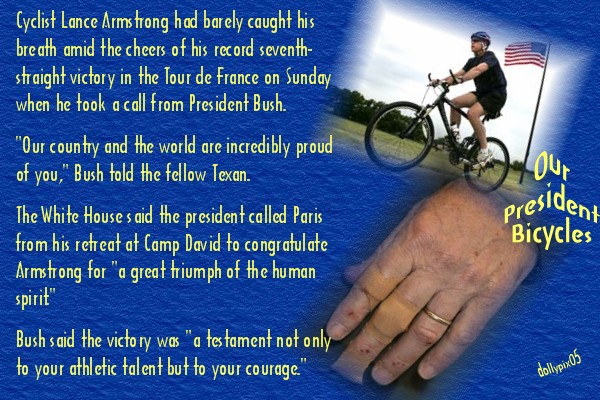
Remarks by the President Bush In
Ceremony Honoring Lance Armstrong
Office of the Press Secretary- The East Room - August 3, 2001 - 3:00 P.M. EDT
THE PRESIDENT: Please be seated. It's my privilege to welcome you all to the White House, and to welcome my friend, a true champ, a great American, Lance Armstrong. (Applause.) America's incredibly proud of Lance, and I know two people who are really proud of him as well, that's Kristin, his wife, and young Luke. Thank you all for coming, as well. (Applause.)
We're also honored to have Chris Fowler of ESPN here. I'm so -- thank you for coming, Chris. I was telling Chris a little earlier, it's one of the programs I can watch on TV that doesn't say anything about me at all. (Laughter.)
I want to thank the members of my Cabinet who are here. Thank you all for coming. I want to thank the members of the United States Congress and the Senate who are here. I see a lot from the Texas delegation here that are sure proud of you.
You all know the Tour de France is perhaps the most physically demanding event in sports. It lasts three weeks, stretches over 2100 miles, and is often run in both sweltering heat and real cold weather. In the end, the race is won or lost in the mountains. During five days of climbs that are incredibly steep and hazardous -- that's when the heart is tested, and that's when Lance Armstrong excels.
In the hardest part of the race, Lance reveals an unbending will, uncommon determination and unquestioned courage. He has shown that courage is sport. He has also shown that courage in life.
Just a few years ago, Lance was diagnosed with cancer. He was weakened by chemotherapy treatments and told he had a 50-50 chance of living. He has done more than survive: He has triumphed. (Applause.)
One observer commented that when you survive cancer, the French Alps start to look like speed bumps. (Laughter.)
Lance's story from cancer diagnosis to a third straight victory in the Tour de France is one of the great human stories. It is a story of character and it is a story of class.
Germany's Jan Ullrich, the 1997 Tour de France champion, is Lance Armstrong's chief competitor. The two of them were leading during a critical stage of this year's Tour de France when Ullrich lost control of his bicycle, missed a turn and ended up in a ditch. When Lance saw what happened, he slowed down in order to allow his chief competitor to recover. It was, as Lance said, the right thing to do.
We need more citizens who know to do the right thing. Lance Armstrong. (Applause.) He's something else, isn't he?
Lance Armstrong is a vivid reminder that the great achievements of life are often won or lost in the mountains, when the climb is the steepest, when the heart is tested. There are many children in this audience who are showing similar determination in their fight with cancer and other serious illnesses. You face tough challenges and you embrace life day by day. You're showing courage on your own journey, and all of us are inspired by your example as well.
Ladies and gentleman, it is my honor to present to you a son of Texas, a great American champion, and an extraordinary human being: Lance Armstrong. (Applause.)
MR. ARMSTRONG: Thank you very much. You know, it's an honor to be here. President Bush has been a friend of ours and a friend of mine for many years, back in -- since his days in Austin, right in the wonderful state of Texas. As an American, as an athlete, to be honored here in the White House, to be welcomed here like this, to see a crowd like this, to see children like this that I've never met before, but I think I relate to very well --
(Luke Armstrong cheers.)
MR. ARMSTRONG: -- even this little guy, I think I relate to very well, who's the most vocal one here. What color is that is that jersey?
LUKE ARMSTRONG: Yo-yo.
MR. ARMSTRONG: Yo-yo, yes. (Laughter and applause.) It's an honor to be here. And again, I can't say enough, to have my family, to have some friends, to have this room full of people to welcome us home and to make us feel like Americans and like -- and maybe even like heroes. I don't know; that's not a word we can give to ourselves, but thanks for having us.
To the kids, good luck, fight hard, stay tough, and believe. Actually, we have one more thing to do. Because, as you see, there's a bicycle here that me and Kristin and Luke would like to present to the President. We expect him to ride it. (Laughter.)
We also have a yellow jersey from this year's Tour de France we would like him to wear while he rides the bike. (Applause.)
(A bike and a jersey are presented.)
PRESIDENT BUSH: Thank you all for coming to the White House. May God bless you all. Thank you. (Applause.)
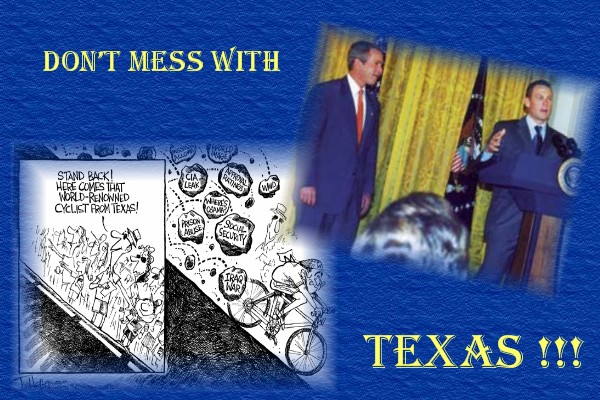
Further reading
• Lance Armstrong, Sally Jenkins: It's Not About The Bike. My Journey Back to Life (ISBN 0425179613), Putnam 2000. Armstrong's own account of his battle with cancer and subsequent triumphant return to bike racing.
• Lance Armstrong, Sally Jenkins: Every Second Counts (ISBN 0385508719), Broadway Books 2003. Armstrong's account of his life after his first four Tour triumphs.
• Linda Armstrong Kelly, Joni Rodgers: No Mountain High Enough : Raising Lance, Raising Me (ISBN 076791855X), Broadway Books 2002. Armstrong's mother's account of raising a world class athlete and overcoming adversity.
Daniel Coyle: "Lance Armstrong's War : One Man's Battle Against Fate, Fame, Love, Death, Scandal, and a Few Other Rivals on the Road to the Tour De France" (ISBN 0060734973), Harper Collins 2000. Former writer for Outside magazine documents Armstrong's road to the Tour in 2004
Links
Lance Armstrong Official Home Page
Born/Built to Win – National Geographic
Paceline – official Fan club site
Testicular/Brain Cancer – an interview in 1997
WearYellowLiveLong
Tour de France
 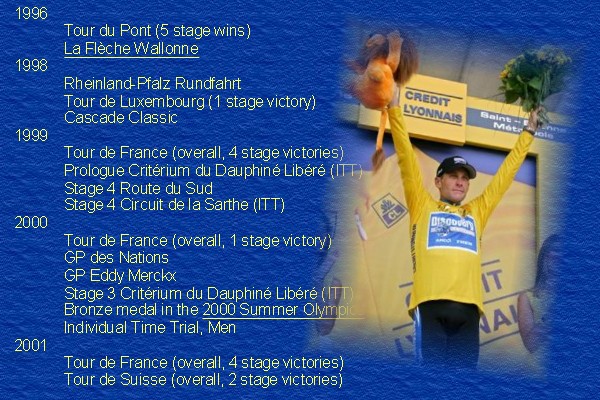
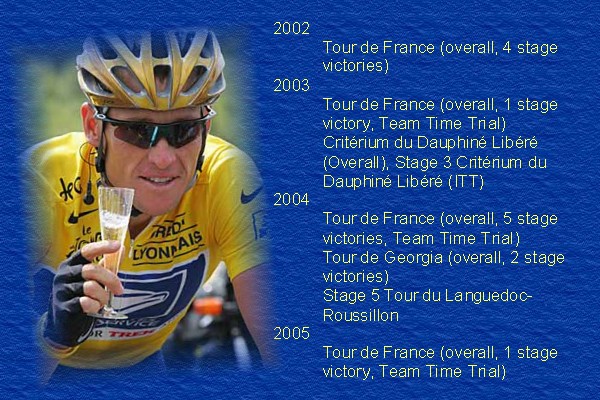
|
|
|
|
|
|
|
|


